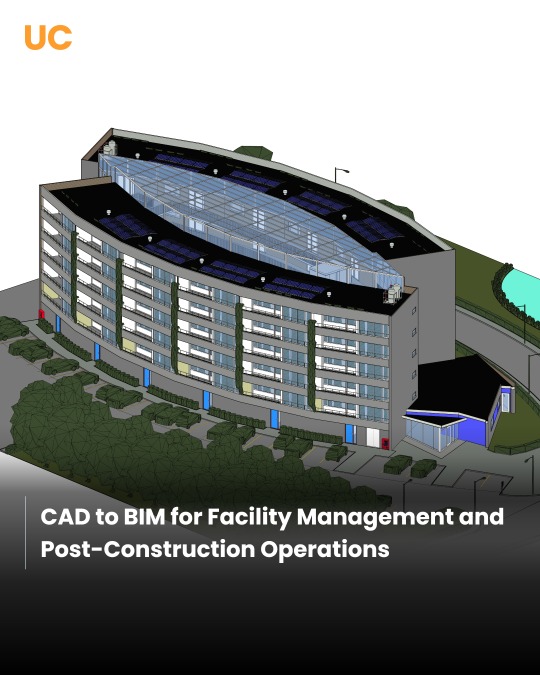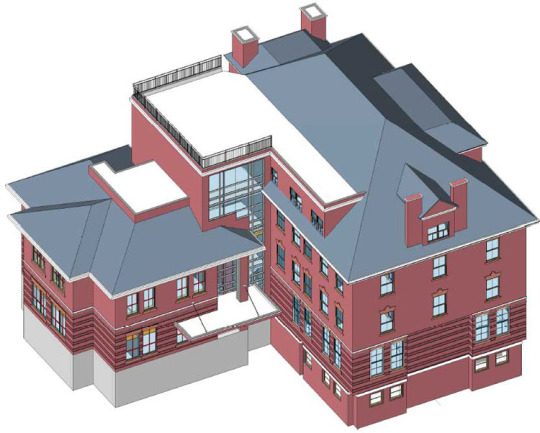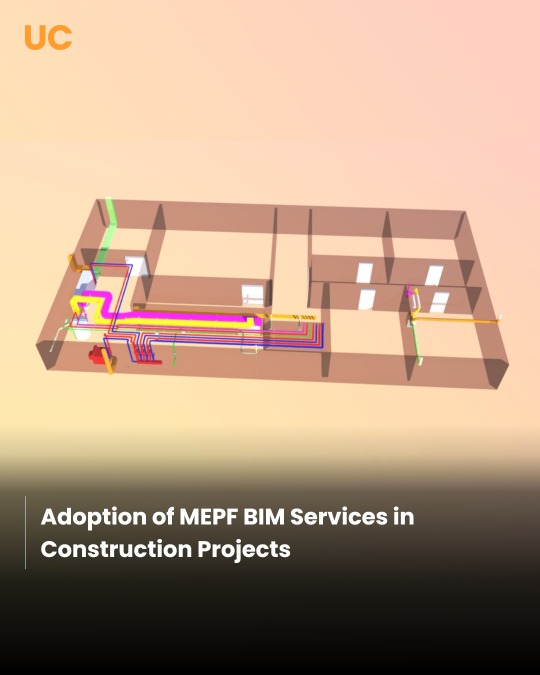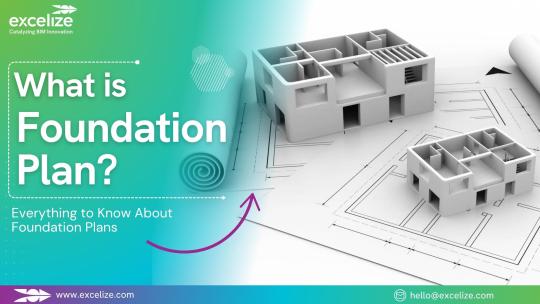#BIM 3D
Explore tagged Tumblr posts
Text
BIM 3D: Revolutionizing the Construction and Design Industry

Understanding BIM 3D
The construction industry has evolved significantly with the introduction of BIM 3D technology. Building Information Modeling (BIM) in 3D enhances project efficiency, accuracy, and collaboration by integrating digital representations of physical and functional characteristics of buildings.
With BIM 3D, architects, engineers, and contractors can create, modify, and manage digital models, ensuring seamless coordination and reduced project risks. This technology not only improves visualization but also streamlines workflow processes, saving time and costs.
How BIM 3D is Transforming the Industry
1. Enhanced Visualization and Design Accuracy
BIM 3D allows architects and designers to create detailed 3D models that provide a realistic representation of buildings before construction begins. This ensures that every design element is accurately planned, reducing design errors and improving efficiency.
2. Seamless Collaboration Across Teams
One of the major benefits of BIM 3D is its ability to connect various stakeholders in a project. Architects, engineers, and contractors can access and edit a shared model, ensuring real-time updates and better coordination.
3. Improved Construction Planning and Cost Efficiency
With BIM 3D, project managers can analyze costs, materials, and schedules before execution. This minimizes unexpected expenses and delays, making construction projects more cost-effective and time-efficient.
4. Clash Detection and Risk Reduction
Errors in design or construction can lead to costly rework. BIM 3D enables clash detection by identifying conflicts between different building elements (such as plumbing and electrical systems), allowing corrections before physical construction starts.
5. Sustainable and Energy-Efficient Designs
BIM 3D supports sustainable building practices by enabling energy analysis, material optimization, and eco-friendly design choices. This contributes to greener construction and better environmental performance.
Key Features of BIM 3D Technology
1. 3D Modeling and Visualization
With BIM 3D, professionals can create high-quality 3D representations of structures, providing better design analysis and visualization for clients and stakeholders.
2. Real-Time Data Integration
Changes made to BIM 3D models are updated in real-time, ensuring all project participants have access to the latest design modifications.
3. Smart Object Technology
Unlike traditional 2D drawings, BIM 3D uses intelligent objects that contain data about materials, dimensions, and specifications. This improves project planning and material estimation.
4. Lifecycle Management
From conceptual design to facility management, BIM 3D covers the entire building lifecycle, ensuring seamless project execution and maintenance.
Applications of BIM 3D in Various Industries
1. Architecture and Interior Design
Architects use BIM 3D to visualize complex designs, test different materials, and ensure aesthetic and functional integrity in their projects.
2. Structural Engineering
Engineers leverage BIM 3D for structural analysis, ensuring buildings meet safety and durability standards before construction begins.
3. Mechanical, Electrical, and Plumbing (MEP) Systems
BIM 3D facilitates the design and coordination of MEP systems, preventing conflicts and ensuring efficient space utilization.
4. Construction and Project Management
Contractors and project managers use BIM 3D for accurate cost estimation, scheduling, and workflow management, improving overall efficiency.
5. Facility Management and Renovation
Post-construction, BIM 3D models serve as valuable resources for maintenance, renovations, and future expansions, ensuring long-term efficiency.
Challenges and Future of BIM 3D
While BIM 3D offers numerous benefits, its adoption comes with challenges such as:
Initial Cost and Training – Implementing BIM 3D requires investment in software and staff training.
Data Management Complexity – Handling vast amounts of project data can be overwhelming without proper tools and expertise.
Standardization Issues – Different organizations use various BIM standards, leading to integration challenges.
Despite these challenges, the future of BIM 3D is promising, with advancements in AI, automation, and cloud computing enhancing its capabilities.
Why Choose Sketcho for BIM 3D Solutions?
For businesses looking to leverage BIM 3D, Sketcho offers cutting-edge solutions tailored to various industry needs. With expertise in digital modeling, project coordination, and advanced visualization, Sketcho ensures high-quality BIM 3D implementation for enhanced project outcomes.
Final Thoughts
BIM 3D is reshaping the construction and design industry by improving accuracy, collaboration, and efficiency. Its applications span across architecture, engineering, construction, and facility management, making it a must-have tool for modern projects.
As the industry continues to embrace digital transformation, adopting BIM 3D ensures better project execution, reduced risks, and optimized costs. Whether you are an architect, engineer, or contractor, integrating BIM 3D into your workflow can enhance project success and sustainability.
Contact Us
0 notes
Text
CAD to BIM for Facility Management and Post-Construction Operations

CAD to BIM for facility management and other post construction operations is a strategic approach for improving the process, safety and performance of infrastructure. Continue to know more how CAD to BIM is beneficial for facility management.
#cad to bim services#bim consulting services#cad to bim conversion#3d bim modeling#cad to bim modeling services#2d cad drawings#bim services#autocad to revit#bim consultant#bim services providers#bim consulting company
3 notes
·
View notes
Text
Connecticut BIM Services - BIMPRO LLC
BIMPRO offers comprehensive BIM services in Connecticut to elevate the design and construction projects across Connecticut locations including Hartford and New Haven.

#BIM Modeling Services Connecticut#Revit Modeling Services Connecticut#BIM Company in Connecticut#3D Modeling Services#BIM Company Connecticut
1 note
·
View note
Text

Building Information modeling (BIM) is an clever software program modeling procedure that engineers, contractors, and designers can use to collaborate on a building’s layout, construction, and operation. It’s extra than just a version. It’s a method of gathering and handling facts at some stage in a building’s whole existence cycle.
BIM encompasses not simplest geometry and spatial relationships, however it also files constructing features, together with unique statistics about the sort of materials used, the quantity used, and the way the ones characteristics effect the building as a whole. BIM may be thought of as a database of facts ranging from task substances and cost – to the 3D version after construction – to operation of the facility. This records may be used to actively control a task each step of the way.
2 notes
·
View notes
Text

BIM Careers: Building Your Future in the Digital AEC Arena
The construction industry is undergoing a digital revolution, and BIM (Building Information Modeling) is at the forefront. It's no longer just a fancy 3D modeling tool; BIM is a collaborative platform that integrates data-rich models with workflows across the entire building lifecycle. This translates to exciting career opportunities for those who can harness the power of BIM.
Are you ready to step into the octagon of the digital construction arena? (Yes, we're keeping the fighting metaphor alive!) Here's a breakdown of the in-demand skills, salary ranges, and future prospects for BIM professionals:
The In-Demand Skillset: Your BIM Arsenal
Think of your BIM skills as your tools in the digital construction toolbox. Here are the top weapons you'll need:
BIM Software Proficiency: Mastering software like Revit, ArchiCAD, or Navisworks is crucial. Understanding their functionalities allows you to create, manipulate, and analyze BIM models.
Building Science Fundamentals: A solid grasp of architectural, structural, and MEP (mechanical, electrical, and plumbing) principles is essential for creating BIM models that reflect real-world construction realities.
Collaboration & Communication: BIM thrives on teamwork. The ability to collaborate effectively with architects, engineers, and other stakeholders is paramount.
Data Management & Analysis: BIM models are data-rich. Being adept at data extraction, analysis, and interpretation unlocks the true potential of BIM for informed decision-making.
Problem-Solving & Critical Thinking: BIM projects are complex. The ability to identify and solve problems creatively, while thinking critically about the design and construction process, is invaluable.
Salary Showdown: The BIM Payday Punch
Now, let's talk about the real knock-out factor – salaries! According to Indeed, BIM professionals in the US can expect an average annual salary of around $85,000. This number can vary depending on experience, location, and specific BIM expertise. Entry-level BIM roles might start around $60,000, while BIM Managers and BIM Specialists with extensive experience can command salaries exceeding $100,000.
Future Forecast: A Bright BIM Horizon
The future of BIM is bright. The global BIM market is projected to reach a staggering $8.8 billion by 2025 (Grand View Research). This translates to a continuous rise in demand for skilled BIM professionals. Here are some exciting trends shaping the future of BIM careers:
BIM for Specialty Trades: BIM is no longer just for architects and engineers. We'll see increased adoption by specialty trades like HVAC technicians and fire protection specialists.
Integration with AI and Machine Learning: Imagine BIM models that can predict potential issues or suggest optimal design solutions. AI and machine learning will revolutionize BIM capabilities.
VR and AR for Enhanced Collaboration: Virtual Reality (VR) and Augmented Reality (AR) will allow for immersive BIM model walkthroughs, facilitating better collaboration and design communication.
Ready to Join the BIM Revolution?
The BIM landscape offers a dynamic and rewarding career path for those with the right skills. If you're passionate about technology, construction, and shaping the future of the built environment, then BIM might be your perfect career match. So, hone your skills, embrace the digital revolution, and step into the exciting world of BIM with Capstone Engineering!
#tumblr blogs#bim#careers#buildings#bim consulting services#bim consultants#construction#aec#architecture#3d modeling#bim coordination#consulting#3d model#bimclashdetectionservices#engineering#MEP engineers#building information modeling#oil and gas#manufacturing#virtual reality#collaboration#bim services#uaejobs
2 notes
·
View notes
Text
Meta Geomatics Property Survey Company
A property survey company plays a crucial role in real estate transactions by providing comprehensive assessments of land and structures. These surveys offer invaluable insights into property boundaries, easements, encroachments, and other critical details essential for legal and development purposes.
Expert surveyors employ advanced technologies like GPS, drones, and 3D scanning to ensure accuracy and efficiency in their evaluations. Whether it's for residential, commercial, or industrial properties, these companies deliver detailed reports that aid in decision-making processes for buyers, sellers, and developers.
Moreover, property survey companies serve as guardians of property rights, helping clients navigate complex regulatory requirements and resolve disputes over land ownership or usage. By leveraging their expertise and cutting-edge tools, they contribute to the smooth functioning of real estate markets and the sustainable development of communities. In essence, partnering with a reputable property survey company is an indispensable step towards ensuring transparency, legality, and peace of mind in any property transaction.
#land survey company#land surveying company#Laser Scanning#Scan to BIM#3D Mapping#property survey company
2 notes
·
View notes
Text
Best BIM services provider - ASC Technology Solutions
ASC Technology Solutions, a premier BIM services provider, excels in offering BIM outsourcing services and 3D modeling services to a global clientele. With a robust team of industry experts, ASC provides innovative and quality BIM services, supporting general contractors, architects, and real estate developers. We ensure precision from LOD 100 to LOD 500, integrating services like BIM modeling, clash detection, and project visualization. Operating from six locations worldwide, ASC has successfully completed complex projects across 20 countries, establishing ourself as a trusted partner in delivering economical and quality-assured Building Information Modeling solutions.
2 notes
·
View notes
Text
Architectural BIM Services: Architectural Drafting & CAD Conversion

Architectural BIM services encompass a range of offerings aimed at enhancing architectural design processes. At Hitech BIM Services, we provide various architectural design services, from converting 2D AutoCAD floor plans into detailed 3D Revit BIM models, transforming CAD drawings into BIM execution plans, and developing full-scale rendered LOD (Level of Development) models following AIA standards, and integrating architectural, structural, and MEP designs to create clash-free models, etc.
Our architectural BIM services provide improved design communication, enhanced coordination with engineers and contractors, and develop comprehensive architectural building designs from existing 2D drafts and CAD models.
As experienced providers of outsourcing BIM architectural services, our team of professional designers excels in BIM platforms and delivers 3D models that meet specific design standards. Partnering with us ensures sustainable building designs, efficient architectural solutions, and precise technical documentation throughout the project lifecycle.
#architecture#building#bim#architectural design#architectural bim services#architectural 3d modeling#outsourcing
3 notes
·
View notes
Text
BIM Coordination Services California
Experience expert BIM coordination services in California. Our BIM modeling company offers MEPF BIM services and architectural expertise.
#BIM Services#BIM Service in California#Architectural BIM Service in California#3D BIM Modeling#Scan to BIM#Clash Detection#MEPF BIM services
2 notes
·
View notes
Text

Erasmus is one of the topmost Outsourcing architectural 3d visualization and rendering company based out of India, offering graphics rich 3D Rendering Services at affordable prices.
#bim services#civilengineering#bim technology#autocad#2d drafting services#constructioncompany#3d render#rendering#3d bim modeling services#3d cad modeling#data entry#architecture#civil construction#renovation#building#wednesday motivation
3 notes
·
View notes
Text
Adoption of MEPF BIM Services in Construction Projects

MEPF BIM services have become a pivotal role player in the AEC sector, offering enhanced coordination, communication and quality outcomes with minimized scope of errors. Read more in detail why leading AEC firms adopt MEPF BIM modeling services.
#mepf bim services#mep bim services#revit mep modeling#mepf bim modeling#mep 3d modeling#mep shop drawing#mep cad services#3d bim modeling#bim consultation#bim mep services
3 notes
·
View notes
Text
CAD to BIM Services in USA - BIMPRO LLC
Our CAD to BIM services in USA provide BIM conversion services by converting PDF drawings or CAD drawings into BIM models.

#CAD to BIM Services#2D CAD to 3D Revit Services#CAD to BIM Conversion Services#2D CAD to 3D BIM Services#CAD to Revit Services
1 note
·
View note
Text
Autocad Course in lucknow | AutoCAD Training in Lucknow | 6390914999

Enroll the best AutoCAD course in Lucknow! Enhance your skills with expert training, practical sessions, and certification. Call us at 6390914999.
#Cad Training Institute in Lucknow#3ds Max Training in Lucknow#Primavera Training in Lucknow#catia training in lucknow#revit training in lucknow#project management training in lucknow#autocad center in lucknow#autocad in lucknow#autocad course in lucknow#BIM Training in Lucknow
0 notes
Text
Top 5 Benefits of 3D Laser Scanning for Heritage Building Documentation in DC

Preserving Washington DC’s architectural legacy is no small feat. From iconic monuments to centuries-old rowhouses, every detail matters.
In today’s AEC (Architecture, Engineering, and Construction) industry, 3D laser scanning has become an essential tool for heritage building documentation.
This technology offers unmatched precision, speed, and reliability, helping architects, engineers, and conservationists protect the historical fabric of our capital city.
In this blog, we’ll explore the top five benefits of using 3D laser scanning for documenting heritage buildings in DC, focusing on how it addresses real-world client needs in historic preservation projects.
1. Unmatched Accuracy for As-Built Documentation

One of the most critical aspects of heritage preservation is capturing a building’s existing condition without error. 3D laser scanning provides millimeter-level accuracy, producing detailed as-built models that reflect the current state of structures, including deformations, deterioration, and unique architectural details.
Why it matters:
Accurate baseline for renovation or restoration
Helps avoid costly rework during construction
Ensures precision for historical compliance and approvals
2. Non-Invasive and Safe Data Collection
Historic buildings often include fragile structures, restricted access zones, or safety hazards. 3D laser scanning enables non-contact measurement, capturing intricate geometry from a distance using LiDAR (Light Detection and Ranging) technology.
Why it matters:
Minimizes physical disturbance to fragile elements
Allows for documentation without scaffolding or demolition
Enhances safety for survey teams and occupants
3. Faster Data Capture with Minimal Site Disruption
Time is always a factor in renovation or heritage conservation projects. Traditional documentation methods can take weeks. In contrast, a single 3D laser scan can capture millions of data points per second, generating a complete spatial snapshot within hours.
Why it matters:
Reduces on-site documentation time
Speeds up project timelines
Minimizes disruption to residents or ongoing operations in heritage zones
4. Enhanced Collaboration with BIM and CAD Integration
Once scanned, the point cloud data can be converted into Revit models, CAD drawings, or 3D visualizations. These deliverables can be easily shared with architects, engineers, contractors, and local preservation authorities for planning and permitting.
Why it matters:
Promotes better collaboration across teams
Enables clash detection and virtual planning
Supports BIM for heritage restoration projects
5. Historical Preservation and Digital Archiving

3D scanning doesn’t just support today’s projects—it also creates a digital time capsule for the future. High-resolution 3D models can be archived for future studies, disaster recovery, or virtual tourism.
Why it matters:
Preserves cultural heritage for future generations
Assists in insurance documentation and disaster recovery
Opens up opportunities for virtual tours and educational outreach
Real-World Application in Washington DC
In DC, where the built environment reflects deep historical and cultural roots, stakeholders including the National Park Service, Smithsonian Institution, local architects, and preservationists are increasingly relying on laser scanning to document and restore landmark properties.
Whether it's Georgetown’s historic homes or Capitol Hill buildings, this technology is becoming a preservation standard.
Final Thoughts
3D laser scanning offers a transformative approach to heritage building documentation in DC. It not only ensures accuracy and safety but also supports sustainable preservation practices aligned with modern AEC trends. As the city continues to balance progress with preservation, adopting advanced tools like laser scanning ensures we respect the past while building for the future.
#construction#architecture#building design#3d laser scanning#bim#urban architecture#3d scanning#laser scanning#technology#washington#usa
0 notes
Text
What is the Foundation Plan? Everything to Know About Foundation Plans

Foundation Plan Drawings are the most important part of any construction project, as they bear the entire load of the house and transfer it to the underlying soil. Proper foundation plans reduce the risk of mistakes made by the construction team and comply with standard building codes.
These plans provide important information, including load-bearing specifications, dimensions, and material requirements. A proper foundation plan can make your building earthquake resistant, flood resistant, and withstand other natural calamities.
In this article, we will cover everything you need to know about foundation plans.
What is the Foundation Plan?
The Foundation Plan is the architectural design that provides information about the layout and design of the foundation. It also includes size, shape, and Materials needed. These drawings make sure the weight of the building is spread equally over the foundation. Structural Engineers or Architects create a Foundation Plan, and it acts as a guide for builders and contractors during the construction.
Components of the Foundation Plan Drawings
Foundation Layout: Foundation Layout demonstrates the complete outline of the building’s foundation, such as walls and columns, as well as the load-bearing elements that support the load of the building.
Footings: Footings are the structural elements that support the building by equally distributing the building’s weight over the soil. This plan shows the types of Footings to use, such as spread footing and slab footing. It also provides information about the footing’s size, shape, and location.
Read more...
#bim consulting services#building information modeling services#bim services#3d bim modeling services#building information modeling#bim consulting firm#bimcoordination#bim service providers#mep bim services#construction
0 notes
Text
An innovative solution to convert RVT to 3DTiles with GISBox
Free on-premise cesium ion alternative
In the fields of smart cities, digital twins, and infrastructure construction, the fusion of BIM (Building Information Modeling) and GIS (Geographic Information System) is an irreversible trend. BIM excels at expressing the shape and attribute information of building components, while GIS excels at managing and visualizing wide-area geospatial data. However, there are significant differences in data format and display logic between these two technologies, and in particular, there are issues with low conversion efficiency, reduced model accuracy, and missing attribute information when converting from RVT (Revit’s native format) to the 3DTiles format used in GIS.
To solve these technical issues, a software platform specialized in 3D data processing, “GISBox,” has been launched. GISBox demonstrates excellent performance and stability in converting RVT to 3DTiles, overcoming the problems of conventional tools. In addition, it is equipped with an automatic optimization function for LOD (level of detail), enabling smooth web display of large-scale 3D scenes.

Strengths of the high-precision, high-performance RVT to 3DTiles conversion engine 1. Directly analyzes Revit models and fully preserves attribute information GISBox can directly read RVT files and convert them without going through intermediate formats such as IFC or FBX. This allows you to preserve BIM attribute information such as the structure’s shape, material, category, ID, and custom parameters without compromising them.
2. Automatic LOD generation for comfortable display of large-scale scenes GISBox is equipped with an LOD generation engine to handle huge models such as city scale and large campuses. It automatically generates the optimal hierarchical structure according to the complexity of the model and the user’s viewing range, achieving a display with “high resolution near and light weight far away.”

Integration with various GIS platforms The 3DTiles output by GISBox conforms to OGC standards and is compatible with the following major platforms:
CesiumJS: Realizes high-precision web 3D visualization instantly
Mapbox GL: Ideal for integrating with vector maps
SuperMap / ArcGIS: Can be integrated with major GIS solutions in Japan
GISBox also provides an OpenAPI interface, and its batch processing and automatic publishing functions allow it to flexibly support enterprise and government systems.
Examples of BIM x GIS integration Smart city: Government converts BIM building models into 3DTiles and integrates them into a digital platform for urban management and emergency response.
Infrastructure construction collaboration: Design offices publish Revit construction models on the web and conduct joint confirmations with the site and clients remotely.
Digital preservation of cultural assets: BIM data of historical buildings is made lighter and 3D views are published on the browser. Contributing to education and cultural promotion.

Conclusion: The era of “moving” 3D data with GISBox Conversion from RVT to 3DTiles is not just a format conversion, but an important step to realize the semantic integration of BIM and GIS. GISBox acts as a bridge to enable BIM data to demonstrate its true value in the GIS world with powerful functions such as an excellent conversion engine, attribute information retention, automatic LOD optimization, and multi-platform support.
In the data-driven future, GISBox will be an indispensable partner in various scenes, from smart city construction to infrastructure design and cultural property preservation.
GISBox Official Teams: https://teams.live.com/l/invite/FEAr12sInvEVy4hFQE Official Teams Group: https://teams.live.com/l/invite/FBAFp0pbqhqlpe1BQI
Contact us to get 7-day Team Plan
0 notes